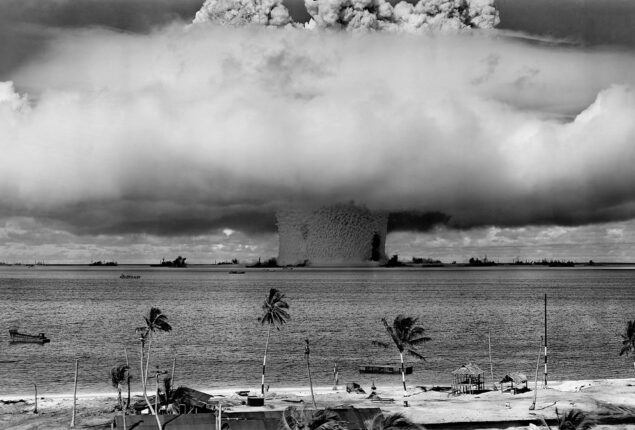
What are the worst Places to Survive a Nuclear War in the U.S.
Many have questioned the likelihood of a nuclear war and the best and worst locations to be if one were to break out in the midst of rising nuclear tensions as the Russia-Ukraine war rages on.
Russian President Vladimir Putin “is not joking,” according to U.S. President Joe Biden, when he discusses the potential use of nuclear weapons. This month, Vice President Joe Biden stated, “I don’t think there’s any such thing as the capacity to easily employ tactical nuclear weapons and not end up with Armageddon.
Putin said in September that if Russia felt threatened, the country would “employ all defence mechanisms at our disposal,” adding that “this is not a bluff.” Ramzan Kadyrov, the leader of Chechnya, who is one of Putin’s cronies, also recently advocated the use of a “low-yield nuclear weapon” in relation to the situation in Ukraine.
The United States possesses 5,428 nuclear weapons, while Russia presently has 5,977, according to figures from the Federation of American Scientists. More over 9,400 of the 12,700 nuclear weapons in existence today, according to the Federation of American Scientists, are kept in military stockpiles for deployment in missiles, aircraft, ships, and submarines.
Experts were recently interviewed by Newsweek to discuss some of the worst locations to be in case a nuclear war broke out in the United States.
The “worst area to be positioned is the place most likely for a nuclear strike,” Dinshaw Mistry, a professor of international affairs and Asian studies at the University of Cincinnati, said in an interview with Newsweek on Thursday.
“The worst place would essentially be strategic targets, such as military and missile bases…bases are basically in the proximity of populated centers, whether it’s cities or towns,” Mistry said. “The worst place is essentially population centers near naval facilities, military bases, strategic air command bases.”
However, Mistry noted that a “major population center” in the U.S., such as New York City or California, “may actually not be the target of nuclear strike.”
According to Kathryn A. Higley, a professor in the School of Nuclear Science at Oregon State University, other potential targets may be infrastructure like power plants or fuel storage facilities.
Worst Places to Be
Similar remarks were made by Mark R. StJ. Foreman, an associate professor at Chalmers University of Technology in Göteborg, Sweden, as he discussed some of the worst locations that may be found if a nuclear bomb were deployed to the United States.
“I would argue that the best place to be during a nuclear attack is in a place where you are not affected by direct effects such as heat and blast and you also have very little fallout radioactivity deposited on your land,” Foreman told Newsweek. “If you were outside in an exposed place near a large nuclear detonation then it would be over in a few seconds—you would be likely to be heated by the infrared light from the bomb. This would cause serious burns, and within seconds you would be hit by the blast wave, which would be likely to kill you.”
Higley added that being “near” to the device’s detonation point would be the worst possible location. Higley asserts that if you are in the targeted area, you will probably pass away very fast, and if you are nearby, you might experience temperature and radiation effects before passing out.
Surviving in the Aftermath
Numerous factors, such as where you are when a bomb is detonated, your level of preparation, and your geographic surroundings, will determine whether you survive a nuclear assault.
When a nuclear bomb is detonated, Foreman indicated that if you are in a bunker, you are probably going to live. However, he said, “there is the problem of what do you do when you come out of the bunker, there is a strong probability that food production and transport will have halted.”
“You might also face a breakdown of law and order,” Foreman said. “One bit of comfort is that many people overplay the problem of mutations in plants, animals and humans. It is unlikely that you will see gross changes in living things around you due to radiation.”
Likelihood of Attack on the U.S.
The director of the Project on Nuclear Issues and a senior fellow in the International Security Program at the Center for Strategic and International Studies (CSIS), Heather Williams, previously told Newsweek that the “likelihood” of Putin using a nuclear weapon “is pretty low” despite ongoing worries about a possible use of such weapons.
“The cost would be so significant for him, it would not help him win the war in Ukraine— he would most likely lose a lot of his close partners he relies on,” Williams said last week.
What Type of Nuclear Weapon Could Be Used
Williams added that the history of nuclear weapons has undergone significant transformation. Williams asserts that the key issue at hand would be “tactical nuclear weapons,” which differ greatly from the ones the US previously employed in Japan.
These nuclear weapons might be employed on the battlefield and would have a smaller yield and shorter range, according to Williams.
Catch all the International News, Breaking News Event and Latest News Updates on The BOL News
Download The BOL News App to get the Daily News Update & Follow us on Google News.




